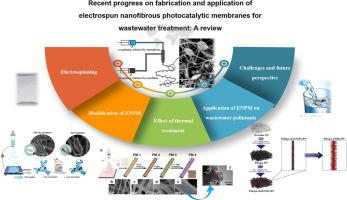Journal of Water Process Engineering ( IF 6.3 ) Pub Date : 2020-12-28 , DOI: 10.1016/j.jwpe.2020.101878 Atikah Mohd Nasir , Nuha Awang , Juhana Jaafar , Ahmad Fauzi Ismail , Mohd Hafiz Dzarfan Othman , Mukhlis A. Rahman , Farhana Aziz , Muhamad Azizi Mat Yajid

|
Presently, photocatalytic degradation has emerged as an attractive and efficient technology for water and wastewater treatment. Many photocatalysts have been introduced and applied to treat organic pollutants in an aqueous system such as dyes, antibiotics, pharmaceuticals, and oily wastes. However, several hurdles, such as difficulty in the suspended photocatalyst segregation from the aqueous system and low reutilization rate, urgently need to be addressed for photocatalytic degradation to be independently implemented in wastewater treatment. The suspended photocatalyst in wastewater needs to be separated to enable the recovery of the spent photocatalyst efficiently. The spent photocatalyst can be regenerated and reused to reduce the operational cost. Therefore, extensive studies have been carried out, targeting photocatalyst immobilization in the nanofibrous membrane to promote the photocatalyst's practical usage in natural wastewater treatment. This review aims to comprehensively discuss the recent progress of the developed nanofibrous photocatalytic membrane, emphasizing advancements in physical and morphological structure towards exhibiting high performance in wastewater treatment. Performance evaluation, challenges, and future directions regarding the utilization of electrospun nanofibrous photocatalytic membranes in wastewater treatment are comprehensively reviewed.
中文翻译:

静电纺丝纳米纤维光催化膜在废水处理中的制备与应用的最新进展
目前,光催化降解已经成为一种用于水和废水处理的有吸引力且有效的技术。已经引入了许多光催化剂并将其用于处理水性体系中的有机污染物,例如染料,抗生素,药物和油性废物。然而,迫切需要解决几个障碍,例如悬浮的光催化剂从水系统中分离出来的困难和低的再利用率,以便在废水处理中独立实施光催化降解。需要分离废水中的悬浮光催化剂,以使废光催化剂有效地回收。废光催化剂可以再生和再利用,以降低运营成本。因此,进行了广泛的研究,以将光催化剂固定在纳米纤维膜上为目标,以促进光催化剂在天然废水处理中的实际应用。这篇综述旨在全面讨论已开发的纳米纤维光催化膜的最新进展,强调物理和形态结构方面的进展,以在废水处理中表现出较高的性能。综述了电纺纳米纤维光催化膜在废水处理中的性能评估,挑战和未来方向。强调物理和形态结构的进步,以在废水处理中表现出较高的性能。综述了电纺纳米纤维光催化膜在废水处理中的性能评估,挑战和未来方向。强调物理和形态结构的进步,以在废水处理中表现出较高的性能。综述了电纺纳米纤维光催化膜在废水处理中的性能评估,挑战和未来方向。











































 京公网安备 11010802027423号
京公网安备 11010802027423号